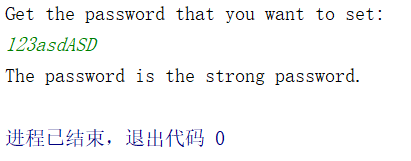python实践项目六:正则表达式-强口令
描述:写一个函数,它使用正则表达式,确保传入的口令字符串是强口令。强口令的定义是:长度不少于8 个字符, 同时包含大写和小写字符, 至少有一位数字。
代码:
1 #!/usr/bin/python 2 # -*- coding: UTF-8 -*- 3 # 写一个函数,它使用正则表达式,确保传入的口令字符串是强口令。强口令的定义是:长度不少于8 个字符, 4 # 同时包含大写和小写字符, 至少有一位数字。你可能需要用多个正则表达式来测试该字符串, 以保证它的强度。 5 import re,pyperclip 6 def detection(text): 7 if (len(text)<8): 8 return False 9 number1=re.compile(r'\d+') #创建一个正则表达式:任意数字,r表示不转义,+表示可匹配多个 10 if number1.search(text)==None: 11 return False 12 number2=re.compile(r'[A-Z]+')#任意大写字母 13 if number2.search(text)==None: 14 return False 15 number3 = re.compile(r'[a-z]+') # 任意小写字母 16 if number3.search(text) == None: 17 return False 18 return True 19 # text=str(pyperclip.paste())#从剪贴板复制命令 20 text=raw_input("Get the password that you want to set:\n") 21 if detection(text): 22 print "The password is the strong password." 23 else: 24 print "Waring:the password is not the strong password!"
运行结果:
示例1:

示例2:

示例3:

哪怕是咸鱼,也要做最咸的那条



